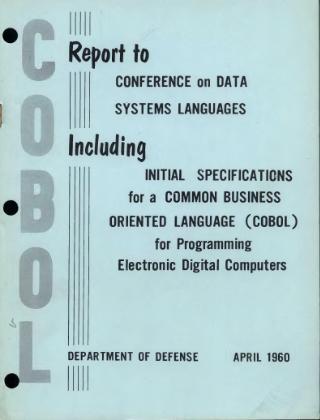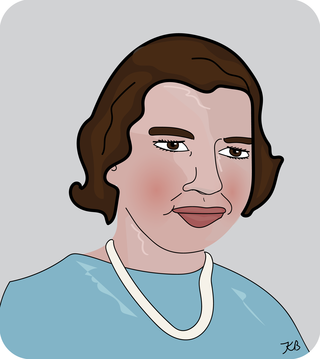Related Research Articles
In computing, a compiler is a computer program that translates computer code written in one programming language into another language. The name "compiler" is primarily used for programs that translate source code from a high-level programming language to a low-level programming language to create an executable program.

COBOL is a compiled English-like computer programming language designed for business use. It is an imperative, procedural and, since 2002, object-oriented language. COBOL is primarily used in business, finance, and administrative systems for companies and governments. COBOL is still widely used in applications deployed on mainframe computers, such as large-scale batch and transaction processing jobs. Many large financial institutions were developing new systems in the language as late as 2006, but most programming in COBOL today is purely to maintain existing applications. Programs are being moved to new platforms, rewritten in modern languages or replaced with other software.

Grace Brewster Hopper was an American computer scientist, mathematician, and United States Navy rear admiral. One of the first programmers of the Harvard Mark I computer, she was a pioneer of computer programming. Hopper was the first to devise the theory of machine-independent programming languages, and the FLOW-MATIC programming language she created using this theory was later extended by others to create COBOL, an early high-level programming language still in use today.
ARITH-MATIC is an extension of Grace Hopper's A-2 programming language, developed around 1955. ARITH-MATIC was originally known as A-3, but was renamed by the marketing department of Remington Rand UNIVAC.
FLOW-MATIC, originally known as B-0, was the first English-like data processing language. It was developed for the UNIVAC I at Remington Rand under Grace Hopper from 1955 to 1959, and helped shape the development of COBOL.
MATH-MATIC is the marketing name for the AT-3 compiler, an early programming language for the UNIVAC I and UNIVAC II.
A system programming language is a programming language used for system programming; such languages are designed for writing system software, which usually requires different development approaches when compared with application software. Edsger Dijkstra refers to these languages as machine oriented high order languages, or mohol.

The history of programming languages spans from documentation of early mechanical computers to modern tools for software development. Early programming languages were highly specialized, relying on mathematical notation and similarly obscure syntax. Throughout the 20th century, research in compiler theory led to the creation of high-level programming languages, which use a more accessible syntax to communicate instructions.
FORMAC, the FORmula MAnipulation Compiler, was the first computer algebra system to have significant use. It was developed by Jean E. Sammet and her team, as an extension of FORTRAN IV. The compiler was implemented as a preprocessor taking the FORMAC program and converting it to a FORTRAN IV program which was in turn compiled without further user intervention.
The Laning and Zierler system was the first operating algebraic compiler, that is, a system capable of accepting mathematical formulas in algebraic notation and producing equivalent machine code. It was implemented in 1952 for the MIT WHIRLWIND by J. Halcombe Laning and Neal Zierler. It is preceded by non-algebraic compilers such as the UNIVAC A-0.
Jean E. Sammet was an American computer scientist who developed the FORMAC programming language in 1962. She was also one of the developers of the influential COBOL programming language.
Short Code was one of the first higher-level languages developed for an electronic computer. Unlike machine code, Short Code statements represented mathematic expressions rather than a machine instruction. Also known as an automatic programming, the source code was not compiled but executed through an interpreter to simplify the programming process; the execution time was much slower though.
History of Programming Languages (HOPL) is an infrequent ACM SIGPLAN conference. Past conferences were held in 1978, 1993, and 2007. The fourth conference was originally intended to take place in June 2020, but was postponed to 2021.
AIMACO is an acronym for AIr MAterial COmpiler. It began around 1959 as the definition of a high level programming language influenced by the FLOW-MATIC language, developed by UNIVAC, and the COMTRAN programming language, developed by IBM. AIMACO, along with FLOW-MATIC and COMTRAN, were precursors to the COBOL programming language and influenced its development.
Scribe is a markup language and word processing system that pioneered the use of descriptive markup. Scribe was revolutionary when it was proposed, because it involved for the first time a clean separation of presentation and content.
The Sort Merge Generator was an application developed by Betty Holberton in 1951 for the Univac I and is one of the first examples of using a computer to create a computer program. The input to the application was a specification of files and the kind of sort and merge operations to use, and the output would be machine code for performing the specification.

In computing, a compiler is a computer program that transforms source code written in a programming language or computer language, into another computer language. The most common reason for transforming source code is to create an executable program.
In computer programming and software development, debugging is the process of finding and resolving bugs within computer programs, software, or systems.

Margaret Helen Harper was an American computer programmer who worked with Grace Hopper at Remington Rand to develop one of the first computer compilers. Harper was born in Michigan, but lived most of her life in Pennsylvania. She attended Wellesley College and graduated from the University of Pennsylvania in 1940. She worked as a programmer and then as a professor.
References
- Hopper, Grace (May 1952). "The Education of a Computer" (PDF). Proceedings of the Association for Computing Machinery Conference (Pittsburgh) May 1952. pp. 243–249. doi:10.1145/609784.609818.
- Hopper, Grace (16 February 1955). "Automatic Coding for Digital Computers" (PDF). High Speed Computer Conference (Louisiana State University) February 1955. Remington Rand.
- Hopper, Grace. "Keynote Address". Proceedings of the ACM SIGPLAN History of Programming Languages (HOPL) conference.
- Ridgway, Richard K. (1952). "Compiling Routines". Proceedings of the 1952 ACM national meeting (Toronto) ACM '52.
- Sammet, Jean (1969). Programming Languages: History and Fundamentals. Prentice-Hall. pp. g. 12.